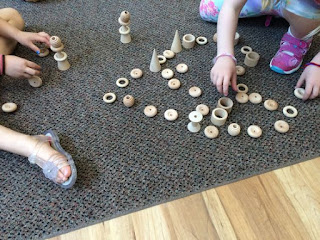I’ve had a lot of discussions with teachers who are
enthused about introducing loose parts to their classroom, but then become frustrated
that the children don’t “do” anything with them. Or, they’re frustrated with
what the children decide to “do” with them – dump them all out, mix them all
together, or other things that don’t match the teacher’s dream of engaged
children arranging natural materials into beautiful designs.
Sometimes children dump and mix because they’re
interested in dumping and mixing. Loose parts, especially small, uniform, loose
parts, are an excellent sensory experience. Pouring, filling, emptying, and
mixing are all natural actions for children. Younger children in particular
might find pouring and filling to be more meaningful schemas than sorting and
patterning.
But sometimes children dump and mix because they don’t know what else to do
with these materials. In the absence of any other cues, they turn to the
familiar – dumping out containers, or mixing objects together to make soup, or
ice cream, or some type of pretend food. When we’re introducing loose parts to
children we need to think not only of the materials, but what we expect the children to do with the materials. We need to set up
environments that encourage children to think “What can I do with this?”
Pomp poms in a basket by themselves suggest dumping.
But paired with tongs and containers, they suggest lifting, grasping, and
filling. Paired with trucks or dollhouses, they suggest filling, transporting,
and pretending.
Containers with different size holes provide a physics
experiment of what will fit through them.
Containers of different sizes, shapes, and dimensions
challenge the children to explore spatial concepts and experiment with how
pieces fit next to, inside, over, and under each other, as well as concepts of number,
volume, length, and ratio.
And, once the children start thinking “What can I do
with this”, their explorations will lead the way.













No comments:
Post a Comment